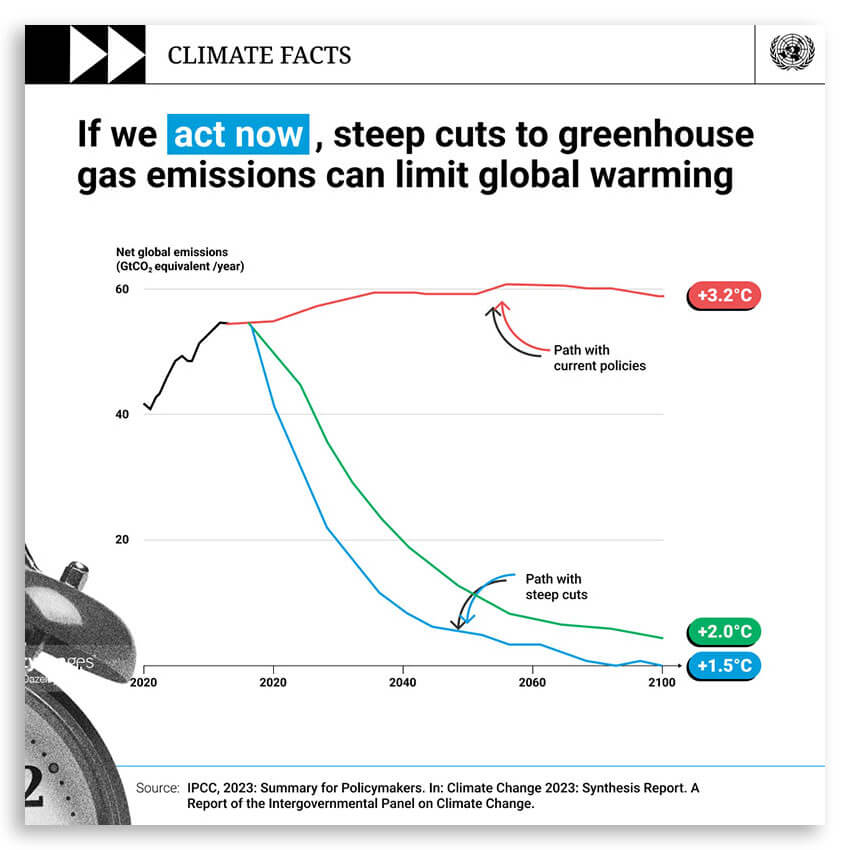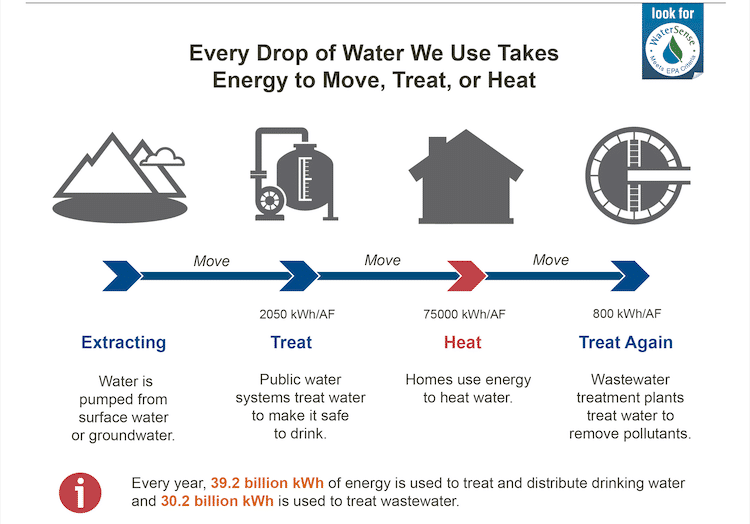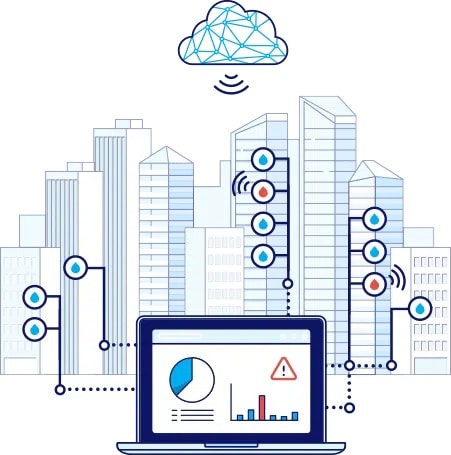Lowering our carbon footprint with an organizational sustainability strategy has never been more necessary.
Heat, drought, wildfires, and declining water supplies are everywhere. A staggering 3.6 billion people live in areas highly susceptible to climate change.
While this sounds overwhelming, humans, especially when coming together in organizations, have the opportunity to make major improvements. Balancing the greenhouse gas you’re producing versus removing from the atmosphere can get you to Net Zero by 2025.
However, despite climate change becoming an increased concern and making headlines, water management has not been given the attention it deserves in climate change discussions.
In fact, 13% of electricity in the US is used for water delivery and treatment. For municipalities, water accounts for a huge 30% – 60% of energy use. While water is often overlooked concerning carbon emissions, it’s actually one of the worst greenhouse gasses and has now been said to be at the center of the climate crisis.
The final nail in the coffin is that over 25% of the water entering a building, construction site, or industrial facility goes to waste. That’s a whole lot of water, amounting to a high carbon footprint and expensive bills.
But whatever your focus is, let’s verify your sustainability strategy and make an impact on both the environment and your bottom line.
What is a Sustainability Strategy?
Sustainability strategies vary from business to business, but generally, they involve creating a comprehensive plan or framework to address environmental, social, and economic challenges that secure long-term viability. The aim is to be responsible regarding resource management for the now and the future, while balancing the needs of the present.
Typically, this involves a set of initiatives to reduce greenhouse gas emissions and preserve natural resources, contributing to less waste.
To do this successfully, a practical plan must be developed, along with KPIs, stakeholder engagement, and employee engagement.
You’ll notice that some businesses share their plan to enforce accountability, while others keep it internal.

Benefits of Implementing a Sustainability Strategy
Before we dive into what makes a sustainability strategy work, let’s talk about why it matters.
- Our planet needs us: “The climate is changing faster than humans, plants, and animals can adapt,” so “every fraction of a degree of warming matters,” explains the United Nations.
- Reduced carbon footprint: As companies, we emit carbon to the environment through suppliers, systems, materials, and more – many opportunities to make a big impact.
- Natural resource conservation: Protecting our natural resources means all living beings will have access to them long term. Turning off faucets at home is good. Reducing water leakages in hospitals is powerful.
- Improved community relations: When you invest in your community, it’s easier to buy locally, reduce your footprint, contribute your team’s skills, and improve your municipality’s sustainability. This impacts employees that live nearby, hence might increase employee engagement. If a more sustainable local policy impacts your operations (say, as a sustainable construction company), actively helping your city become more eco-friendly can reduce bottlenecks.
- Economic benefits: 91% of Gen Z want to buy from sustainable companies, and 37% want to work for these companies. Gen Zers are almost a third of the workplace too, so true sustainability could give you a competitive advantage when hiring talent that has a choice.
Key Components of a Sustainability Strategy
As you plan your strategy, be ambitious but also realistic. Here are the components your strategy needs to be well executed.
Setting Clear Sustainability Goals
Start by clarifying what you’re working toward. Set specific short and long-term goals.
- Instead of “we’d like to reduce water waste,” choose…
- “We’d like to reduce water waste by 25% within this amount of time.”
Assessing Current Practices and Impact
Look at what your company is already doing. To start, look for low-hanging fruit. Are there any smaller elements that you can tweak or stop?
By assessing current practices, rather than jumping straight into new processes, can save you money as you may already have software or a team member who can help you reach your goal.
Results via Key Performance Indicators [KPIs]
It’s important to leave some things open for interpretation and creativity, yet what counts as success isn’t one of them.
Break your KPIs into smaller goals with deadlines, then review progress regularly. You’ll be able to see what’s working and what needs adjustment before challenges escalate.
10 Practical Steps for Building a Sustainability Strategy
You can make a huge difference to the planet and your company with an efficient sustainability strategy. Here’s how.
1. Vision and Objectives
Define sustainability and its meaning for your organization. Consider: Where do you see your company in 10 years? How will your vision impact your employees, customers, suppliers, and community?
The level of ‘green’ you’re hoping to achieve could define the strategy going forward, so it’s imperative you know what you want to improve on and succeed with.
For example, there is a difference between green, sustainable, and resilient. Green refers to buildings and measures that benefit the environment. Sustainable means the structure meets certain building certifications or standards that measure its environmental performance. In contrast, resilience refers to designing a strategy to withstand natural disasters.
Once you’ve decided on the goals, establish clear, measurable, time-bound, and achievable objectives. Divide them into gradually more ambitious quarterly and annual goals.
2. Stakeholder Engagement
Identify and categorize relevant stakeholders, including:
- Customers
- Employees
- Your c-suite
- Investors
- Local communities
Analyze their interests, concerns, and expectations. Then, decide how you’ll continuously involve them with your progress, including:
- Meetings
- Surveys
- Newsletters
- Social media
But before moving forward with other stakeholder categories, ensure your c-suite isn’t only engaged but owns the process. You need strong leadership commitment to consistently deliver for everyone else.

3. Assessment and Baseline
Research where you’re currently standing with top goals. Look at what’s currently working. Are any goals being undermined by unnecessary activities, expenses, or bottlenecks?
Some business challenges could be overcome by implementing a sustainability strategy. For example, conserving water whenever possible has become a huge goal for many in this climate crisis – with both the planet and our pockets feeling the cost.
This has become a business issue for many with the rising cost of bills and insurance. Implementing efficient plumbing fixtures, water reuse tools, and solutions to manage water could solve this problem, while being kinder to the environment too.
Maintaining a baseline level for what’s expected with these could be advantageous.
To give you examples from our construction customers:
Some face large insurance costs due to water leaks. Stopping leaks is crucial to both their finances and the environment. When making these assessments, consider the current pitfalls your business may be facing.
4. Regulatory and Compliance Review
Your sustainability framework must comply with your industry and/or region’s regulations and laws. As more information about climate change is discovered, adaptations to current regulations are likely.
Bring your regulation officer or consultant on board for this journey to verify you’re compliant throughout.
Many companies seek a LEED (Leadership in Energy and Environmental Design) certification. This is a point-based framework to create healthy, highly efficient, and cost-saving green buildings. WINT’s AI-based water management system, which alerts of water leaks and automatically shuts them off, is one of the cheapest sets of LEED points you can get.
5. Framework and Guidelines
Your framework allows your team to understand what they’re working on, why, and how, keeping everyone on the same page at every step.
A solid framework should include a defined vision and practical goals, all of which should be based on priorities. Within this, explain who’s in charge of what, the schedule, and what resources they can access to meet their specific goals.
Clarify how and when work will be reviewed and measured and specify incentives.
6. Create an Action Plan
An action plan for your sustainability strategy will make it easier to get c-suite collaboration, ownership, and budgets. If the plan is public, your progress can sway customer decisions, which can keep your company accountable.
Develop initiatives that align with sustainability objectives and then assign roles and responsibilities for implementing initiatives to the relevant people. There should also be a timeline for implementation.
In terms of actions, ensure you’re focusing on green initiatives like being energy efficient, using sustainable materials and proper maintenance practices, and water conservation.
7. Implementation
Have an implementation plan so your strategy gets executed and makes the difference you know it can make.
Get one of the c-suite positions to take ownership of your sustainability strategy and involve your employees and other key stakeholders. Every employee’s voice matters as they’ll all have a different perspective and are likely the ones who’ll be implementing your decisions.
Conduct proper resource allocation – enough time, money, and human resources. Listen to people’s feedback, review KPIs, and adjust. Set clear goals, KPIs, timelines, and milestones – then follow through with reviews.
8. Monitoring and Evaluation
Even if you have the best team members in the world, aligning so many people with so many responsibilities on one track isn’t easy. Therefore, you should plan specifically how this data will be collected and analyzed. Determine how feedback should be gained and brought in and put milestones and reviews on the schedule.
Ideally, this data should be accessible from a cloud-based dashboard so communication and collaboration is easy. This way everyone knows what to do in case of a challenge or bottleneck.
9. Reporting and Disclosure
As you allocate resources in your sustainability strategy, leave some for reporting and disclosure. Learn the recognized sustainability reporting standards, such as…
- Global Reporting Initiative (GRI).
- Sustainability Accounting Standards Boards (SASB).
Investors often want to see the four Cs of sustainability reporting, explains the International Institute for Sustainable Development (IISD). The four C’s include:
- Concise
- Consistent
- Current
- Comparable
That’s likely true for all your stakeholders. Plus, transparency in your reporting, especially when things don’t go well, is valuable for trust-building with stakeholders. Adding what you plan to do to improve also helps.

10. Technology and Innovation
We created WINT’s AI-based water management system because we believe in the power of technology to scale our human efforts and free us up for bigger visions and strategies. Let’s use WINT as an example, though innovative solutions likely exist for all top goals in your sustainability strategy.
WINT intelligently identifies leak and waste sources in real-time. Our system alerts teams and can automatically shut leaks off, which massively reduces carbon emissions and reduces water consumption by 20-25% on average.
We’ve recently helped The Empire State Realty Trust who own the Empire State Building to improve sustainability and prevent water damage. This has led to annual savings of $100K, 7.5M Gallons and 300 tons of carbon per year. It doesn’t end there though, Microsoft, Mastercard, HP, and Google have experienced the powers of WINT too.
Start Implementing Sustainability Solutions
Focus your sustainability strategy on your most critical goals. If you’re passionate about communities having access to clean and safe water (without compromising future generations), you know sustainable water management is essential.
We need efficient water use and conservation, reuse and recycling, awareness and education, and integrated water resources management.
With a consistent water savings track record, we can help you be part of the solution.
Get in touch with WINT, and let’s explore how we can turn your sustainability strategy into a successful implementation that makes a real difference.

